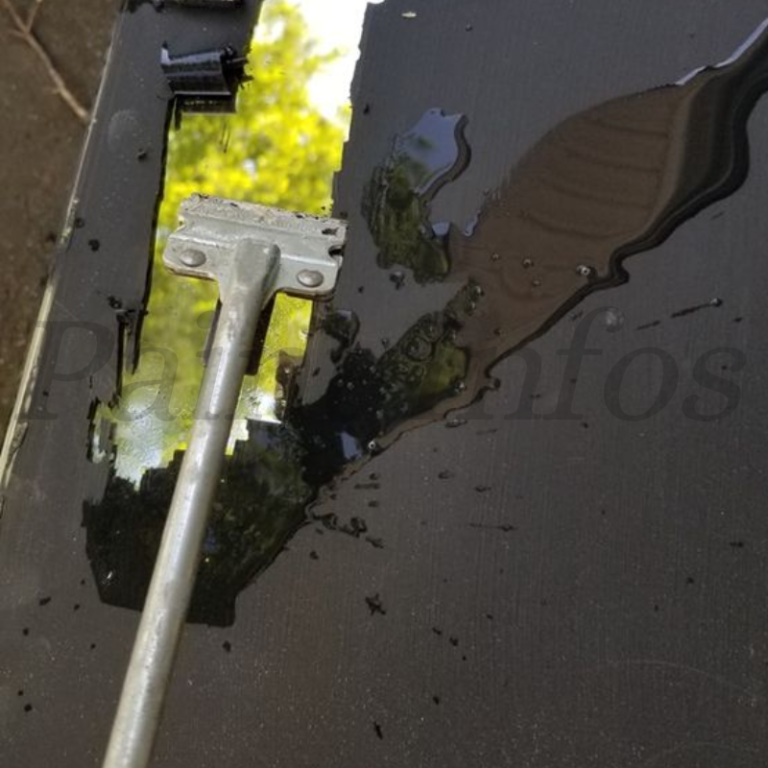If your paint job is starting to look a little tacky, you may be wondering if you can simply paint over it. The short answer is yes, you can paint over tacky paint. However, there are a few things you need to do first in order to ensure that your new paint job will look its best.
- If the paint is still tacky, you can try painting over it with another coat of paint
- Make sure to use a primer first and let the primer dry completely before painting over it with your top coat
- If the paint is dry but has a tacky feel, you may need to sand down the surface before repainting
- Use a fine-grit sandpaper and lightly sand the surface until it feels smooth
- Wipe away any dust with a damp cloth before painting over it
- If you’re dealing with glossy paint that’s become tacky, you’ll need to etch the surface before repainting
- To do this, mix 1 part vinegar with 3 parts water and apply it to the surface with a sponge or brush
- Let it sit for 10 minutes before rinsing it off and then drying the surface completely
How Do You Paint Over Tacky Paint?
Before you can paint over tacky paint, you need to clean the surface thoroughly. Tacky paint is often caused by a build-up of dirt and grease, so it’s important to remove this before painting. Once the surface is clean, you can then apply a fresh coat of paint.
Can You Paint a Second Coat Over Tacky Paint?
If you’re wondering whether you can paint a second coat over tacky paint, the short answer is yes! You can definitely paint over tacky paint, but there are a few things you should keep in mind first.
For one, make sure that the tacky paint is completely dry before attempting to apply a second coat.
If it’s even slightly damp, the new coat of paint will not adhere properly and will likely result in an uneven finish.
Another thing to consider is the type of paint you’re using. If you’re using an oil-based paint, it’s best to wait at least 24 hours before applying a second coat.
However, if you’re using a water-based or latex-based pain, you can usually get away with painting over tacky paint after just a few hours.
Finally, be sure to use a good quality primer before painting over tacky paint. This will help ensure that the new coat of paint goes on smoothly and evenly.
Why is My Paint Still Tacky After 24 Hours?
If your paint is still tacky after 24 hours, there are a few possible explanations. The most likely explanation is that the paint wasn’t given enough time to dry before you attempted to touch it or move something else around in the room. Paint needs at least 24 hours to fully cure, so if you can give it a full day to dry, that would be ideal.
Another possibility is that the paint you used wasn’t meant for indoor use. Some paints are only meant for outdoor use and won’t properly cure when used indoors. If this is the case, you’ll need to repaint using an appropriate paint for indoor use.
Finally, it’s also possible that the humidity levels in your home are too high for the paint to properly cure. If this is the case, you may need to open up some windows or run a dehumidifier in order to lower the humidity levels and help the paint curing process along.
How Do You Strip Paint That is Tacky?
Paint that is tacky can be tricky to strip. If you try to scrape it off, you may end up taking the paint off the surface underneath. The best way to strip tacky paint is with a chemical stripper.
You can find these at most hardware stores. Follow the directions on the bottle, and be sure to wear gloves and protective eyewear. Once the stripper has done its job, you should be able to easily peel the paint off.
Will Tacky Paint Eventually Dry
Whether you’re dealing with a drippy faucet or a paint can that won’t stop dripping, it can be frustrating to wait for something to dry. But how long does it really take for tacky paint to dry?
It depends on the type of paint and the conditions in which it is drying.
latex paints usually take about an hour to dry under normal conditions. However, if the humidity is high or the temperature is low, it can take longer for the paint to dry. Oil-based paints can take anywhere from 6 to 24 hours to dry completely.
Again, humidity and temperature will affect the drying time.
If you’re impatient like me, you may be tempted to speed up the drying process by using a hair dryer or turning up the heat. However, this is not recommended as it can cause bubbles or cracks in the paint.
The best way to ensure that your tacky paint dries properly is to simply be patient and wait for it to dry under normal conditions.
Paint Still Tacky After a Year
If your paint is still tacky after a year, there are a few possible explanations. The most likely explanation is that the paint wasn’t properly cured when it was applied. Paint needs to be exposed to air and sunlight in order to cure properly, so if it was applied in humid or shady conditions, it may not have cured correctly.
Another possibility is that the paint was old or of poor quality, which can also prevent proper curing.
If your paint is still tacky, you’ll need to sand it down and repaint. Make sure to prepare the surface properly before painting again, and use a good quality paint this time around.
With proper preparation and paints, your new paint job should last for many years without issue!
How to Fix Sticky Paint
If you’re dealing with sticky paint, there are a few things you can do to try and fix the problem. First, you’ll want to make sure that the paint is completely dry. If it’s not, then it’s likely that the stickiness is due to moisture in the paint.
You can try using a hairdryer or heat gun to speed up the drying process.
Once the paint is dry, you can try sanding down the affected area. This will help to rough up the surface of the paint so that it’s less likely to be sticky.
If sanding doesn’t work, then you may need to strip off all of the paint and start again from scratch.
Finally, if all else fails, you can always contact a professional painter for help. They’ll be able to identify the cause of the sticky paint and fix it quickly and easily.
Can You Prime Over Tacky Paint
If you’ve ever painted a room, you know that the key to a good paint job is in the prep work. One of the most important steps in prepping for painting is to make sure the surface is clean and free of any dirt, dust, or grease. Otherwise, your paint won’t adhere properly and you’ll end up with a tacky mess.
The same principle applies when you’re trying to prime over tacky paint. If the paint is already tacky, it’s not going to hold onto the primer very well. This can lead to peeling and flaking down the road.
So, if you’re thinking about priming over tacky paint, think again! It’s not worth the risk.
The best way to deal with tacky paint is to remove it completely and start from scratch.
This may seem like a lot of work, but it’s really the only way to ensure that your new paint job will turn out perfect. So don’t be tempted to skip this critical step – your walls will thank you later!
Conclusion
If you’re wondering whether you can paint over tacky paint, the answer is yes! You can definitely paint over tacky paint, but there are a few things to keep in mind first. Make sure that the tacky paint is completely dry before painting over it.
If it’s even slightly damp, the new paint will not adhere properly and will likely peel off. Once the tacky paint is dry, sand it down until it’s smooth and then apply a primer before painting. With these simple tips in mind, you can easily give your space a fresh coat of paint without having to remove the old, tacky paint first.



